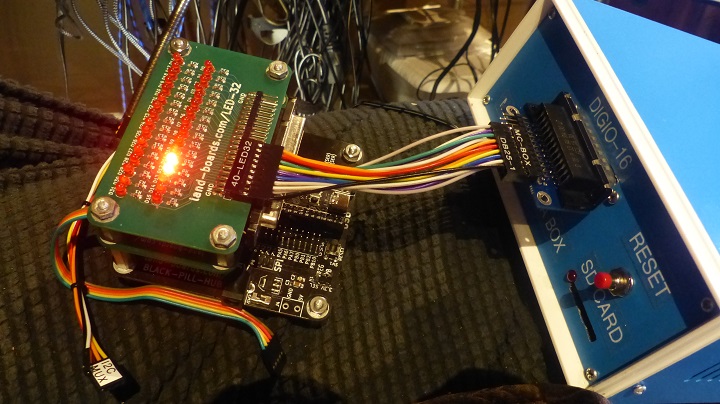Difference between revisions of "IOP16 General Purpose I/O (GPIO)"
Jump to navigation
Jump to search
Blwikiadmin (talk | contribs) (Created page with "== General-purpose I/O == From [https://github.com/nealcrook/multicomp6809/blob/master/multicomp/Components/GPIO/gpio.vhd Neal Crook's simple GPIO unit]. * A simple GPIO uni...") |
Blwikiadmin (talk | contribs) |
||
| (5 intermediate revisions by the same user not shown) | |||
| Line 1: | Line 1: | ||
== General-purpose I/O == | == General-purpose I/O == | ||
| + | |||
| + | <video type="youtube">0M8n1_wLdEc</video> | ||
| + | |||
| + | [[file:IOP-16_LEDs_P18125_720px.jpg]] | ||
From [https://github.com/nealcrook/multicomp6809/blob/master/multicomp/Components/GPIO/gpio.vhd Neal Crook's simple GPIO unit]. | From [https://github.com/nealcrook/multicomp6809/blob/master/multicomp/Components/GPIO/gpio.vhd Neal Crook's simple GPIO unit]. | ||
| Line 37: | Line 41: | ||
** 3 DDR3 bits [7:0] | ** 3 DDR3 bits [7:0] | ||
* After reset, GPIOADR=0, all DDR*=0 (output) all DAT*=0 (output low). | * After reset, GPIOADR=0, all DDR*=0 (output) all DAT*=0 (output low). | ||
| + | |||
| + | == Entity == | ||
| + | <pre> | ||
| + | -- ____________________________________________________________________________________ | ||
| + | -- GPIO Unit by Neal Crook - Built for 6809 Multicomp | ||
| + | -- https://github.com/nealcrook/multicomp6809/blob/master/multicomp/Components/GPIO/gpio.vhd | ||
| + | gpio : entity WORK.gpio | ||
| + | port MAP ( | ||
| + | n_reset => w_resetClean_n, | ||
| + | clk => i_clock, | ||
| + | hold => '0', | ||
| + | -- conditioned with chip select externally | ||
| + | n_wr => not w_peripWr, | ||
| + | dataIn => w_peripDataFromCPU, | ||
| + | dataOut => w_GPIO_Out, | ||
| + | -- 0 for GPIOADR, 1 for GPIODAT | ||
| + | regAddr => w_peripAddr(0), | ||
| + | -- GPIO | ||
| + | dat0_i => w_dat0_i, | ||
| + | dat0_o => w_dat0_o, | ||
| + | n_dat0_oe => w_n_dat0_oe, | ||
| + | dat2_i => w_dat2_i, | ||
| + | dat2_o => w_dat2_o, | ||
| + | n_dat2_oe => w_n_dat2_oe | ||
| + | ); | ||
| + | </pre> | ||
| + | |||
| + | == Resources (EP4CE15) == | ||
| + | |||
| + | * Logic Cells: 40 | ||
| + | * Registers: 30 | ||
| + | * Memory bits: 0 | ||
Latest revision as of 16:12, 19 April 2022
General-purpose I/O
From Neal Crook's simple GPIO unit.
- A simple GPIO unit for a 6809 multicomp.
- Aims to provide a number of programmable I/O lines all accessed through an indirect mechanism using 2 locations in the processor address space.
- The operation is fully synchronous on the master clock; a clock enable determines when the state changes.
- Design by Neal Crook foofoobedoo@gmail.com Jun2015.
- You are free to use this file in your own projects but must never charge for it nor use it without acknowledgement.
GPIO PROGRAMMING INTERFACE
- The software interface is through 2 read/write registers, usually decoded at the following addresses :
- regSel = 0 - GPIOADR
- regSel = 1 - GPIODAT
- GPIOADR specifies the register to access. GPIODAT provides data read/write to selected register.
- Using a 16-bit store you can generate an atomic register select/data write.
- There is no equivalent mechanism for reads.
- Therefore, if any ISR ever accesses a GPIO register, you must bracket any GPIO register operations with disable/enable of interrupts.
- It's probably safest simply to never access GPIO within an ISR.
- When you have written a value to GPIOADR (either with an 8-bit or 16-bit store) you can perform multiple GPIODAT reads and writes to the selected register; there is no need to re-write GPIOADR until you wish to select a different register. Beware of interrupts though; see note above.
- For each group of physical pins there are 2 registers in GPIO.
- The odd register is the data direction register
- The even register is the data register.
- A 0 in the data direction register marks the bit as an output, and a 1 marks it as an input
- (mnemonic: 0utput, 1nput)
- A write to the data register sends the write data to the pin for each bit that is an output
- A read from the data register samples the pin for each bit that is an input, and returns the last value written for each bit that is an output.
- When you switch a pin from input to output, it will immediately assume the value that was most recently written to it.
- The following registers are implemented:
- 0 DAT0 bits [2:0]
- 1 DDR1 bits [2:0]
- 2 DAT2 bits [7:0]
- 3 DDR3 bits [7:0]
- After reset, GPIOADR=0, all DDR*=0 (output) all DAT*=0 (output low).
Entity
-- ____________________________________________________________________________________ -- GPIO Unit by Neal Crook - Built for 6809 Multicomp -- https://github.com/nealcrook/multicomp6809/blob/master/multicomp/Components/GPIO/gpio.vhd gpio : entity WORK.gpio port MAP ( n_reset => w_resetClean_n, clk => i_clock, hold => '0', -- conditioned with chip select externally n_wr => not w_peripWr, dataIn => w_peripDataFromCPU, dataOut => w_GPIO_Out, -- 0 for GPIOADR, 1 for GPIODAT regAddr => w_peripAddr(0), -- GPIO dat0_i => w_dat0_i, dat0_o => w_dat0_o, n_dat0_oe => w_n_dat0_oe, dat2_i => w_dat2_i, dat2_o => w_dat2_o, n_dat2_oe => w_n_dat2_oe );
Resources (EP4CE15)
- Logic Cells: 40
- Registers: 30
- Memory bits: 0
